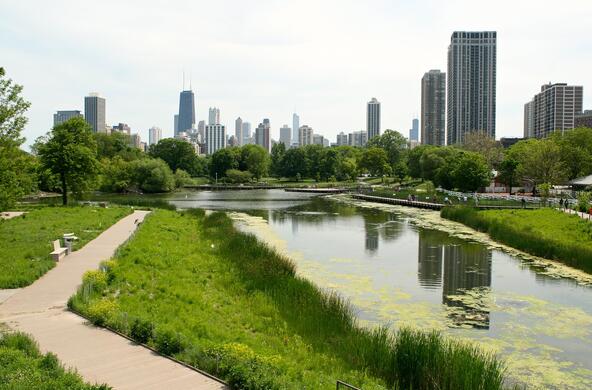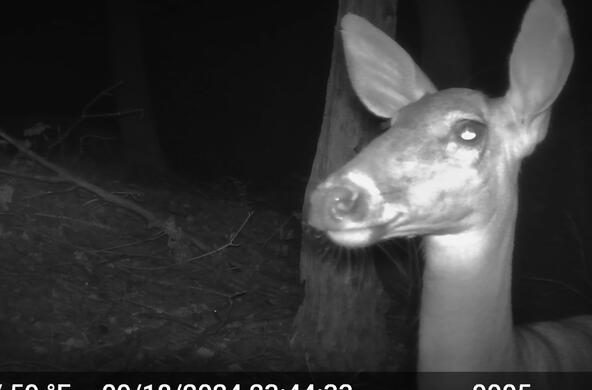When we think of nature in cities, we often think about major green expanses, places like Central Park in New York City or Griffith Park in Los Angeles. But in these cities and others, little patches of greenery — sometimes forgotten, often overlooked — can be very important for the local environment.
“One thing people often do when they think about biodiversity in cities is to automatically think about the really big places,” says Steward Pickett, a plant ecologist at the Cary Institute of Ecosystem Studies, “especially the big parks that have some relatively wild looking parts.” But Pickett points out that, when you look at cities or towns a bit closer, you come to realize that there are so many small spaces that offer some sort of ecological benefit, like little patches of trees or shrubs that might be shared across a couple of yards, or small strips of greenery between properties: “All sorts of little corners,” as Pickett says.
In fact, all these slight bits of natural life can have biological value, even unkempt places like vacant lots. “As an ensemble, it can have real value for biodiversity,” Pickett says.
One example of a small space that offers big potential is the traffic roundabout. Simon Leather is an entomologist and a professor at Harper Adams University in the United Kingdom who began studying the biological benefits of roundabouts while trying to impress upon his students the idea that conservation is a local issue as well as a global one. “Being an entomologist, I get really cross about how much money and time is spent on the large charismatic megafauna, which are just such a small proportion of the world’s biodiversity,” Leather says. He often finds students picturing coral reefs and Siberian tigers when the topic of conservation comes up. “And I just think they’re missing so much at home — I was trying to think of a way that I could make them understand that.”
In the early 2000s, Leather was living in a town called Bracknell, known for its unusually high number of roundabouts. Driving a little over six miles, Leather would pass through 13 different roundabouts, and it dawned on him that the vegetation in the center might be a haven for biodiversity — an idea that sparked over a decade of research. Since then, he and his students have learned that, yes, roundabouts can harbor rich varieties of species, and the more thoughtfully designed, the better the outcome. “The important thing about roundabouts to make them good for biodiversity is that they have some structure,” Leather says. That’s a simple task, as easy as creating different layers of grass height, or just being a bit more inventive and including different types of growth, like shrubs and trees. Introducing native species creates a better habitat for wildlife, and since the only humans that enter the space are the groundskeepers, these areas remain pretty isolated, which encourages their development.
Leather’s work has begun to inspire smarter roundabout design and maintenance. Certainly this is the case in Bracknell, where his research began. Leather provided the town with annual reports on the state of the roundabouts, often giving suggestions for improvement based on his findings. Occasionally, his work would end up in the press, and other towns began to contact Bracknell about their roundabout designs and management. In Newport, where he lives now, the town plants native wildflowers in their roundabouts, which he credits to the better understanding of roundabout ecology uncovered by his and his students’ research.
Getting the attention of local government is key — and plenty of them are listening, not just in the U.K. but also in the United States. “Chicago has for a long time recognized the value of the green spaces that are spread throughout the Chicago metropolitan area,” Pickett says — as has Baltimore, where Pickett directs the Baltimore Ecosystem Study, an ongoing, 20-year project that aims to understand how urban areas work as ecological systems. “Baltimore is a really nice example of awareness of science and plugging it into designs,“ Pickett says; he credits the Baltimore Office of Sustainability with that. It’s the sort of government office that often connects city planning and management groups with the best scientific knowledge available; such offices play a significant role in bringing together different departments to work on projects from different angles.
And community participation is just as important as government involvement. Based on the Baltimore project, Pickett and his team have learned to stop thinking of their work as outreach and to start thinking of it as engagement. “It’s a two-way kind of communication that has been the most effective for us in Baltimore,” he says. That includes listening to the concerns and ideas of those living in the area and sharing data from both sides whenever they can. Conversations between the Department of Public Works and researchers with the Baltimore Ecosystem Study, for example, led to a project that focused on water quality in areas where storm sewer infrastructure had aged and was causing water pollution.
“The joint project emerged out of listening to what each ‘side’ was doing, and what they were learning and trying to accomplish,” says Pickett, and it ultimately resulted in improved water management and quality of life within the affected neighborhoods.
The important thing about roundabouts to make them good for biodiversity is that they have some structure.
Education plays a big part as well. The Baltimore Ecosystem Study includes a branch geared toward bringing their work into schools and offers science-based research programs that students can get involved with. As for Leather, his work got its start in classrooms, and he’s been able to develop it as a tool for teaching students about biodiversity and conservation. Undergraduates, master’s students, and doctoral candidates have participated in his research, as Leather learned right along with them, often to his surprise, how clearly greenspace size and type of vegetation contributed to animal species diversity and population size. They’ve also described the rather large number of species such small spaces can foster, finding over 240 species of bugs and beetles as well as 44 species of birds on Bracknell roundabouts alone. Additionally, being able to introduce these ideas to students out in the field has allowed Leather to instruct students on various ecological sampling techniques.
In some of the more substantial findings of his research, Leather has found that even small places like roundabouts can promote conservation, as he observed in one of the larger roundabouts in Bracknell that supported beetle populations typically found only in undeveloped areas. “If you’ve got the habitat there, then you can encourage the less common species onto it,” he says. That roundabout, the Sports Centre Roundabout, is one of Leather’s favorites. (His other favorite lies in the south of France and it has less to do with the vegetation and more to do with the giant ant sculptures that appear to be walking across it. He is an entomologist, remember.)
The Baltimore Ecosystem Study found some intriguing correlations between vegetation and crime. One of the Study’s projects calculated that a 10 percent increase in tree cover was associated with a nearly 12 percent decrease in crime. Two explanations for this change are that the presence of trees might reduce aggression — or they might encourage time outdoors, fostering social networks and inadvertent neighborhood surveillance.
Pickett sees two main challenges to this type of work. One is the constant changing of the environment and evolution of the cities. What drives changes in the environment and growth in cities and how the two interact is always shifting. “So there are many things that are changing right now and will continue to change in unexpected ways,” Pickett says, “the big challenge is to keep this work going.” A second challenge is its inherent interdisciplinary nature. “You have to be truly integrated so that you’re not satisfied with models that only look at social processes or only look at biological processes,” Pickett says, “but you realize that you’ve got to be looking at models and studies that integrate those things.”
“Those are existential challenges to the research, but they’re also great opportunities,” he adds.






